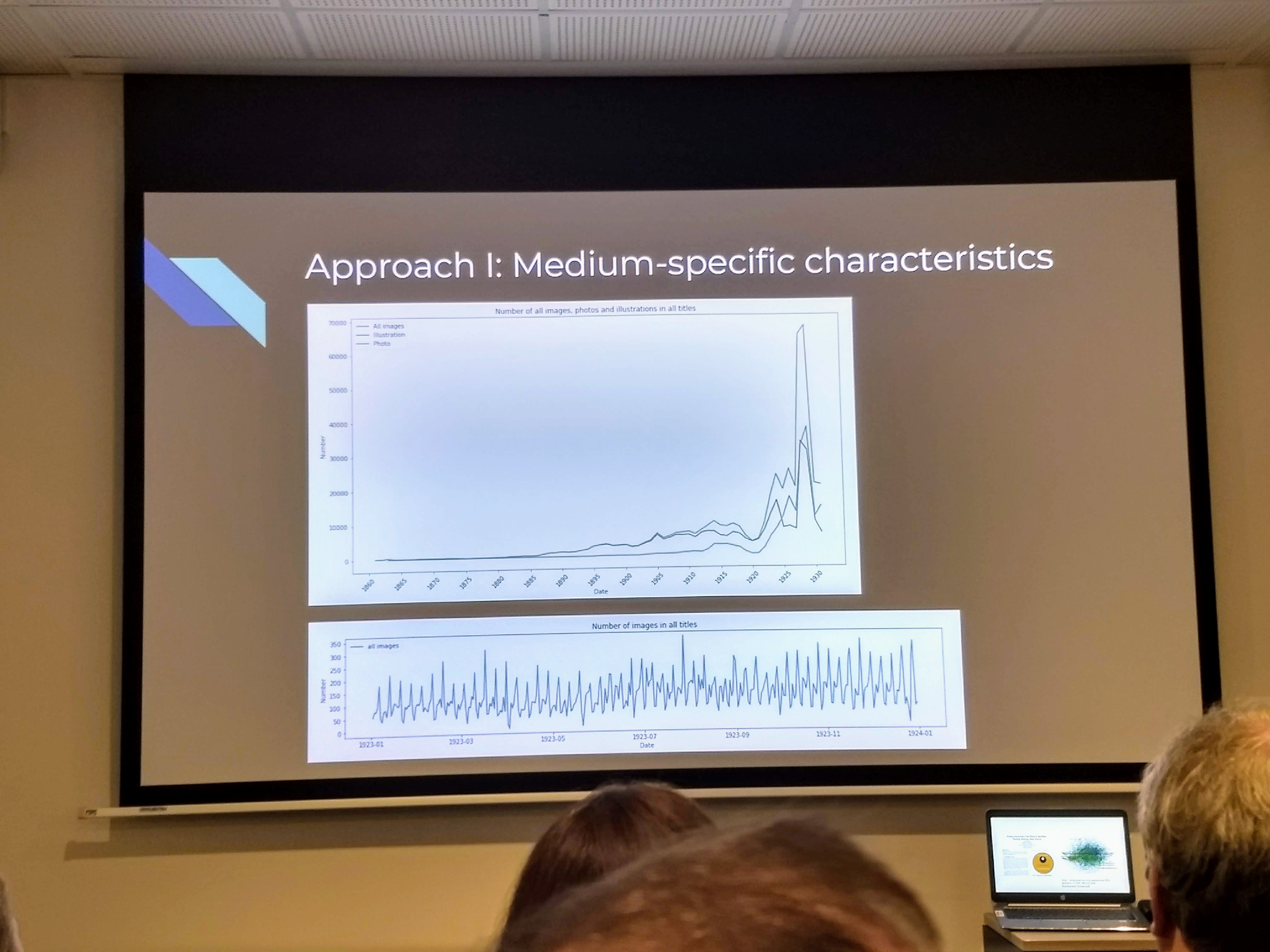Last week I was at the fifth annual DHBenelux conference, held at the International Institute for Social History in Amsterdam. At this conferences, scholars presented and discussed state of the art research in digital humanities in close to 100 contributions (for more about the types and source of submissions, see my analysis). The theme of this year’s conference was Integrating Digital Humanities, a theme that succeeded to remain present throughout the conference. In the below blogpost, I will review some of the many interesting paper and discussions I have attended. It is not intended to provide a complete overview of the conference, which is (physically) impossible with three parallel sessions, but I hope the below discussion will provide some insights in the work on integration in digital humanities in the BeNeLux.
Integrating digital technology
The immediately obvious form of integration in DH is the integration of digital technology in humanities scholarship. In the first paper of the conference, Joris van Zundert1 argued that computer code is also an argument, and should thus be taken as scholarship. Scholars ignoring the code leads to so-called 'screen essentialism', the assumption that the only research of interest is what appears on screen, while more importantly the code is the model of the research. The graphical representation is instead a distraction from that research. In the same session, Marijn Koolen2 argued for tool criticism, a critical reflection on the place of digital tools during research, and reviewed their work on defining how tool criticism works in practice. My own paper in this session (short-listed for the best paper award)3 presented my survey on collaboration in digital humanities, and the interactions between humanities scholars and computer researchers. The findings of my survey indicate that these interactions may be far fewer than assumed, with collaborations conducted on a large distance with humanities scholars outnumbering computer researchers. During the Q&A afterwards, I was asked about the involvement of cultural heritage institutes and libraries in these collaborations, where I questioned the extent to which such institutes can be considered collaborators in DH, or act more as (mere) data providers.
Integrating libraries
This brings me to the second integration, which was present throughout many discussions of the conference, the integration of libraries in digital humanities collaborations. Based on my survey, in the panel on libraries in DH,4 I asked whether librarians are the third wheel of DH collaborations, wishing to be omnipresent, but hardly so. Instead, librarians are often ignored by humanities scholars and computer researchers. Most librarians in the room were unconvinced of this, and argued that libraries do have a lot to offer for digital humanities scholarship. What exactly the library should offer remained an open question. Since DH is a fast-moving field, it is easy to become overly ambitious and turn librarians into full-time data scientists, experts of the large amount of DH tools, high-performance computers, and more. This balancing of what DH requires and what librarians can meaningfully offer is a discussion that was not easily answered.
In her keynote, Jane Winters5 discussed web archives, which have existed for twenty years, yet are still hardly used by historians. She questioned how the web should be archived, and how this material can be made useful for historians. As the web is too large to fully archive, web archives tend to overemphasize disastrous events such as terrorist attacks, as these are then used as points to archive online representation. In her paper, Valérie Schafer6 discussed multiple web archives, describing the problem as the silence and noise of archives; web archives as containing huge gaps, but also huge amounts of data. Clearly, archives and libraries can learn here from historians in deciding what to archive and how these archives should be used for historical research.
In aggregation of digitized objects, a debate occurred on which party is responsible for scalable and sustainable solutions. Mark Depauw7 presented the Trismegistos project as an aggregator of objects from multiple sources. Their project collects metadata from multiple sources and assigns identifiers to distinct objects. During the Q&A he was critiqued for this practice, with the argument that the task of assigning identifiers should not lie with a research project, but with the cultural heritage institutes. However, during the next presentation from Mike Priddy8 on the EHRI project, he discussed the problem that many heritage institutes did not assign identifiers to objects. Another problem was that in aggregating metadata, they found that institutes provided incompatible metadata, so that a full-on integration of metadata meant leaving out the most interesting parts.
Finally, a very succesful demonstration of collaboration between researchers and libraries was the presentation by Melvin Wevers and Thomas Smits (winners of the best paper award).9 They presented their work at the National Library of the Netherlands, where they explored digitized newspapers with computer vision techniques. For example, they studied the rise of illustrations and photographs in newspapers as representations of events and found that illustrations started appearing from the 1880s onwards, and photos overtook illustrations from approximately 1925 onwards.

On Twitter, head of research at the National Library of the Netherlands Martijn Kleppe argued this research perfectly showcases the collaboration beween scholars and libraries:
- 1. An Ethnography of Codework: Making the Epistemology of Digital Humanities Coding Visible – Joris van Zundert, Smiljana Antonijevic, Tara L. Andrews
- 2. Lessons Learned from a Digital Tool Criticism Workshop – Marijn Koolen, Jasmijn van Gorp, Jacco van Ossenbruggen
- 3. Boundary practices in digital humanities– Max Kemman
- 4. Integrating Libraries and Digital Humanities – Michiel Cock, Esther ten Dolle, Steven Claeyssens
- 5. Humanities and the born digital: moving from a difficult past to a promising future? - Jane Winters
- 6. Digital Social Networks of the Past: Issues, Limits and Challenges – Valérie Schafer
- 7. Bridging the Gap between Academia and Museums – Mark Depauw
- 8. Assessing integration capabilities in the Cultural Heritage Sector – Mike Priddy, Linda Reijnhoudt
- 9. Seeing History: Analyzing Large-scale Historical Visual Datasets Using Deep Neural Networks – Melvin Wevers, Thomas Smits, Willem-Jan Faber, Juliette Lonij
Redefining collaboration
The opposition of libraries in DH as either a data provider or a collaborator is not satisfying.1 Librarians are obviously data providers, holding the digitized material that scholars want to explore and investigate in DH projects. However, librarians do not just hold these data, they know them. Librarians are the people who know best how to access, how to store, and how to reference digitized material. Scholars ignoring the role of librarians in DH will end up reinventing wheels that have long ago stabilized in libraries. I am personally not convinced librarians need to act as full-on and omnipresent collaborators with respect to experimentation and analysis as data scientists (as discussed in the panel), but it is important to recognize that librarians have 'a very particular set of skills' that will make their contributions valuable to many DH projects. It is thus absolutely necessary to recognize that digital humanities not only concerns the integration of computer science in humanities scholarship, but also the integration of information science.
Contributions of the C²DH at DHBenelux 2018
- Argumentation Mining in Political Debates – Shoreh Haddadan, Elena Cabrio, Serena Villata, Leendert van der Torre
- Digital Social Networks of the Past: Issues, Limits and Challenges – Valérie Schafer
- WW1 (fallen) soldiers on-line: databases as traces of collective memories – Frédéric Clavert
- Corpus creation and digitized newspapers – perspectives from research and libraries – Marten Düring, Estelle Bunout, Steven Claeyssens, Sally Chambers, Pim Hujnen, Jaap Verheul, Clemens Neudecker
- Transparency as a prerequisite for Digital Source Criticism for Digitized Newspapers – Marten Düring, Estelle Bunout, Steven Claeyssens, Sally Chambers, Pim Hujnen, Jaap Verheul, Clemens Neudecker
- Boundary practices in digital humanities – Max Kemman
- 1. This is also a conclusion from a recent paper considering the collaboration between librarians and digital humanities projects:
Poole, A. H., & Garwood, D. A. (2018). “Natural allies”: Librarians, archivists, and big data in international digital humanities project work. Journal of Documentation, 74(4), 804–826. http://doi.org/10.1108/JD-10-2017-0137



